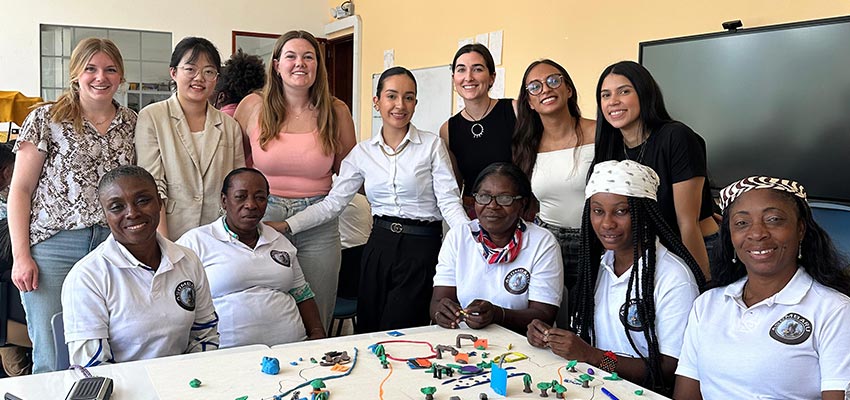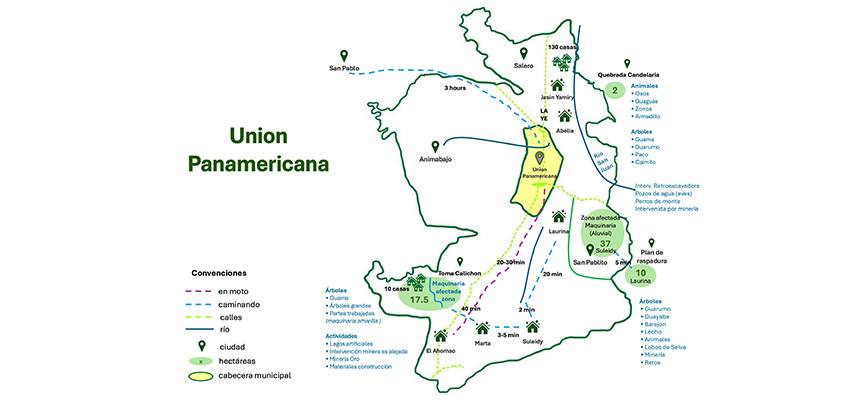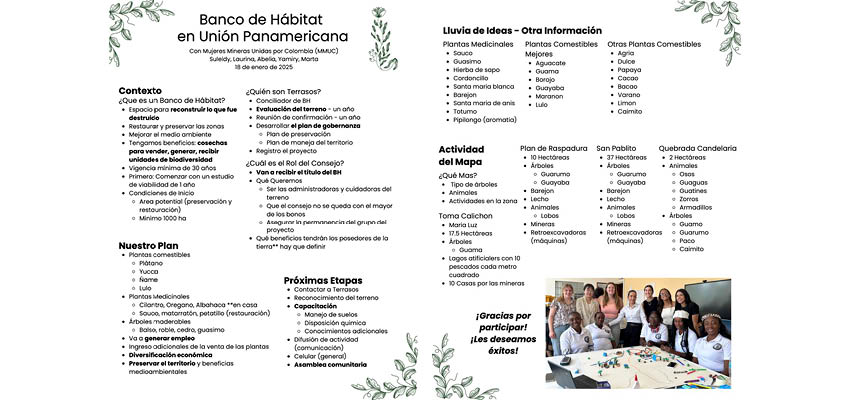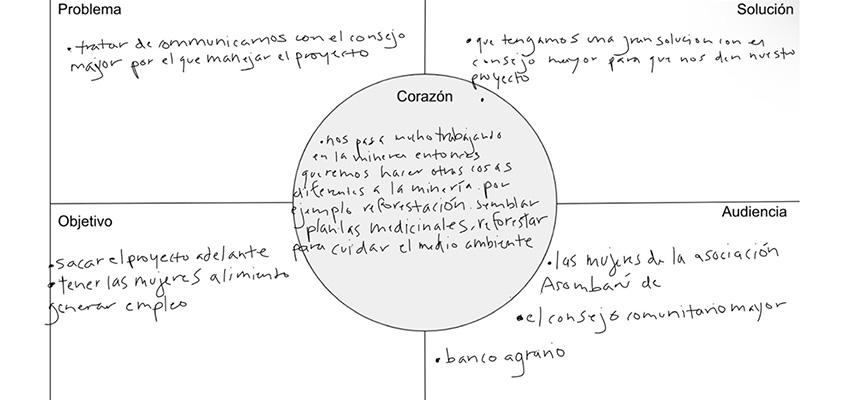
In January 2025, a group of students from the MIT class D-Lab: Gender and Development traveled to Medellín, Colombia with D-Lab Associate Director for Practice Libby McDonald, to work alongside Mujeres Mineras Unidas Por Colombia (MMUC) on a transformative initiative: developing bancos de hábitat (habitat banks). These banks are designed to preserve biodiversity by designating areas of land for restoration and conservation, generating biodiversity credits for participation in the voluntary carbon market. This innovative model addresses urgent environmental concerns while creating opportunities for economic diversification in the region. Together with MMUC members and students from Universidad Nacional de Colombia (UNAL), we began envisioning how this initiative could take shape in Unión Panamericana, a municipality in Chocó.
Mapping the land: empowering communities through information
A central element of the project was creating an info map with MMUC members and UNAL students. This began with a hands-on activity where community members modeled landscapes, natural resources, and human activities using clay. This physical map made the process interactive and drew upon the participants' deep familiarity with the land.
Once the clay model was complete, we translated its details into a digital map to make the information clearer and more practical. This map highlighted biodiversity, land use, and areas impacted by mining, identifying zones for restoration and agroforestry alongside those altered by retroexcavation or artificial lakes. For example, San Pablito, an area rich in biodiversity, was identified as a priority for agroforestry with species like guayaba and paco, which could also generate income. Similarly, areas near Quebrada Candelaria were noted for reforestation, providing an opportunity to mitigate the effects of nearby mining activities.

The mapping process provided more than data; it established a shared understanding of the region's resources, challenges, and opportunities. This collective perspective united the community around common goals for sustainable development and biodiversity conservation.
Empowering women’s leadership: Preparing for the consejo
A pivotal step in advancing the Banco de Hábitat initiative was preparing MMUC members to present their proposal to the Consejo Comunitario, the local governing body responsible for land use decisions. Securing the Consejo's approval was critical, as it would hold the official title to the Banco de Hábitat.
To support the women in this effort, we collaborated with MMUC members and students from UNAL to create a comprehensive guide that clearly outlined the project’s goals, benefits, and implementation plan. The guide introduced the concept of a Banco de Hábitat as a space dedicated to restoring damaged land, preserving biodiversity, and fostering sustainable economic opportunities. It detailed how the initiative would promote income diversification through agroforestry, with crops such as yucca, lulo, medicinal plants, and timber species like roble and guásimo providing both ecological and financial benefits. A governance plan was also included to ensure responsible land management, emphasizing active community participation in preservation and restoration efforts.

Proposed guide for presenting the Banco de Hábitat initiative to the Consejo
This preparation was more than just organizing content; it was an opportunity for MMUC members to demonstrate their leadership. The process of refining the proposal and practicing its delivery gave the women confidence to present their vision and advocate for its value. By aligning the Consejo and the community around the project’s shared benefits, the women’s leadership became a testament to the power of grassroots-driven change.
Moving beyond mining: crafting solutions through collaboration
Before arriving in Colombia, we focused our research on women’s roles in mining, particularly their contributions and the fight for pay equity. However, discussions with MMUC members shifted our understanding. Mining, while central to the community, was often described as exhausting and limiting. For many women, it was not a choice but a necessity—a default option rather than an aspiration.
These discussions revealed an important perspective: while their work in mining is undeniably significant, it does not fully represent their aspirations or potential. They spoke of the difficulties of juggling roles as caregivers, workers, and community members, and their desire for opportunities that aligned with their aspirations and values. From these discussions, agroforestry emerged as a promising alternative. With crops like lulo, yucca, and guayaba, alongside medicinal plants and timber species, the women saw potential to diversify their incomes while restoring biodiversity and improving the land.

This shift was grounded in participatory design, a collaborative approach that involves community members at every stage. Through co-design workshops and collaborative mapping, MMUC members shared their knowledge and envisioned a future for their land. This participatory process ensured that the project was built on their priorities rather than external assumptions, creating solutions that felt truly their own.
While the project remains in its early stages, the participatory design approach has already laid a foundation for meaningful progress. This is not just about moving beyond mining—it is about creating pathways that reflect the women’s hopes for their community and their land.
Looking forward
Our time in Medellín was filled with moments that left a lasting impression—the hospitality of the people, the breathtaking landscapes, and the vibrant energy of the city. Sustainability, here, is not just an abstract concept but something deeply embedded in daily actions and shared understandings.
This project is still unfolding, and its full impact will take time to reveal itself. As we reflect on the conversations we’ve had and the ideas we’ve explored together, we carry a sense of gratitude and hope. We look forward to seeing how this work, rooted in collaboration and shared purpose, continues to take shape in the hands of the community.
About the authors
This post was written by students from MIT D-Lab’s Gender and Development course:
- Lilly Heilshorn – Massachusetts Institute of Technology, Class of 2025, Bachelor in Mechanical Engineering
- Amanda Bendixen – Massachusetts Institute of Technology, Class of 2025, Master in City Planning
- Yvonne Chang – Harvard University, Class of 2025, Ed.M. in Education Policy & Analysis
- Aashi Agarwal – Harvard University, Class of 2025, Master in Public Policy
- Olivia Torres – Wellesley College, Class of 2026, Bachelor in International Relations
- Gaby Loredo – Wellesley College, Class of 2027, Bachelor in Economics
We extend our heartfelt thanks to Mujeres Mineras Unidas Por Colombia (MMUC) and Universidad Nacional de Colombia (UNAL) for their collaboration and partnership in creating meaningful change.
More information
Contact
Libby McDonald, Lecturer, MIT D-Lab Associate Director for Practice

